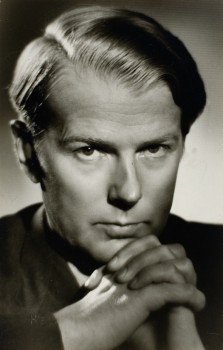Debt to life
28 May 2014 | Authors, Non-fiction

Kaarlo Sarkia (1902–1945). Photo: Ivar Helander (The Literary Archives/Finnish Literature Society)
Joie de vivre, dream, death, love: Kaarlo Sarkia’s rhymed poetry made him one of the Finnish classics, even if he only had time to publish four collections. Like several unfortunate poets of the first half of the 20th century – among them Edith Södergran, Saima Harmaja, Katri Vala, Uuno Kailas – he died of tuberculosis. Poems from Unen kaivo (‘The well of dreams’, WSOY, 1936)
From the point of view of both form and content, Kaarlo Sarkia’s poem ‘Älä elämää pelkää’ (‘Don’t be afraid of life’, 1936) is among the best examples of Finnish poetry. It crystallises several typical themes and features of his work: a declamatory absoluteness and existential courage, a faith in beauty, and the presence of death.
Don’t be afraid of life,
don’t shut out its beauty.
Invite it to sit by your fire,
or should your hearth expire,
to meet it outside is your duty.
– – –
Älä elämää pelkää,
älä sen kauneutta kiellä.
Suo sen tupaasi tulla
tai jos liettä ei sulla,
sitä vastaan käy tiellä,
älä käännä sille selkää.
– – –
Sarkia (1902–1945) is a Romantic. For him ‘beauty grows from under weights of pain’: the awareness of death gives rise to an ecstatic love for life and the flowers of a garden glow most intensely just before the autumn frosts. Art is sacred, and the longing for the unattainable produces a mysterious happiness: ‘the unattainable remains / the only thing that is your own’.
In Sarkia’s poetry the emotions spring from the dream and from death. The titles of his four collections of four names reflect the core of his work: Kahlittu (‘Chained’ ,1929) , Velka elämälle (‘Debt to life’, 1931), Unen kaivo (‘The well of dreams’, 1936) and Kohtalon vaaka (‘The scales of fate’, 1943). Powerful contrasts dominate the cosmos of the poems: darkness and brightness, ecstasy and pain, hope and despair. Recurring motifs are the road, the window and subjects drawn from nature, especially flowers. The ‘I’ of the poems is fully conscious of its fate, which is often associated with the experience of strangeness and alienation. One of the reasons for this – observed by later research – was Sarkia’s homosexuality. In ‘Kuvastimesta’ (‘In the mirror’) the speaker is a stranger even to himself, and the poem can be read as a portrayal of the divided ego: Strange and truly wondrous / in the mirror you look at me. / All I really know is / that you I cannot be.
In the spirit of the Romantic tradition, love is fateful and usually hapless. The lovers have been forced to part for reasons that are not disclosed, and tragedy intertwines with memories of happiness, creating a ‘a beauteous / sorrow’. Some of these poems, like ‘Erottua’ (‘Separated’) have lived on as classics of Finnish love poetry. The poem ‘Paennut’ (‘The one who fled’) refers to the riddle that separates the lovers: Did I love you? / That I do not know. / In my soul I trembled / when you turned to go.
Kaarlo Sarkia has remained in the history of Finnish poetry as a composer of words: his poems are masterful in their euphony and rhythm. In their metrical structure they not only employ end-rhymes but also chains of assonances and rhythmic repetitions that cross the verse lines and create the impression of musical echoes and patterns. It is not surprising that many of Sarkia’s poems have been set to music – by, for example, the composers Erik Bergman and Kaj Chydenius – and neither is the fact that they have remained almost untranslated. When modernism conquered Finnish poetry in the 1950s, metrical verse became unfashionable; on one occasion Sarkia’s formal virtuosity became the target of parody by the eminent modernist poet Eeva-Liisa Manner.
Some of Sarkia’s poems imitate the rhythm of the actions that they portray. For example, ‘Rukkilaulu’ (‘Spinning song’) uses the rhythm of the spinner’s foot kicking the wheel to make it rotate and carry the yarn. The poem presents two images at once: on the one hand an idyllic childhood memory of the poet’s mother treading the wheel, and on the other a view of human destiny as a spinning wheel, of life at the mercy of a kind of wheel of fortune.
A skilled translator, Sarkia focused in particular on Finnish versions of French and Italian poetry. Among the poets he translated were François Villon, Victor Hugo, Charles Baudelaire, Gabriele D’Annunzio; his translation of Arthur Rimbaud’s ‘Le Bateau Ivre’ is considered brilliant. The Swedish Romantic E.J. Stagnelius and the French poet Alfred de Musset were among his kindred spirits.
Although to the modern reader Sarkia’s language sounds old-fashioned and his burning idealism may seem unfamiliar, many of his poems are still fresh and thought-provoking. A good example is ‘Älä elämää pelkää’, whose ethos (or aesthetic pathos) of living in the moment and fearlessly confronting life is ageless.
– – –
Do not ever say:
this is mine alone.
Drink from life’s cup
and once again give its pain up.
If you never beg to own,
the world’s riches are yours today.
Be bold, stake all on one card:
ahead you will always see death’s gate unbarred.
Älä koskaan sano:
‘Tämä on iäti minun.’
Elon maljasta juovu,
taas siitä, jos tarpeen, kivutta luovu.
On maailman rikkaus sinun,
kun mitään et omakses ano.
Elä pelotta varassa yhden kortin:
näet aina avoinna kuoleman portin.
Translated by David McDuff
Tags: biography, classics, poetry
No comments for this entry yet
Leave a comment
-
About the writer
Satu Grünthal (born 1961) is an adjunct professor of Finnish literature at the Universities of Helsinki and Turku.
© Writers and translators. Anyone wishing to make use of material published on this website should apply to the Editors.
